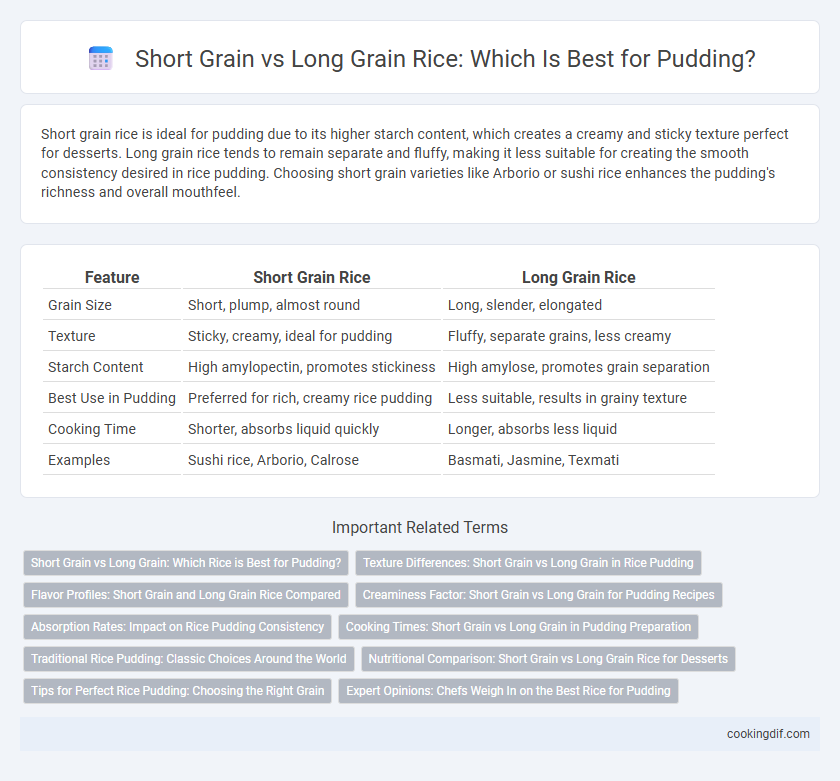Short grain rice is ideal for pudding due to its higher starch content, which creates a creamy and sticky texture perfect for desserts. Long grain rice tends to remain separate and fluffy, making it less suitable for creating the smooth consistency desired in rice pudding. Choosing short grain varieties like Arborio or sushi rice enhances the pudding's richness and overall mouthfeel.
Table of Comparison
| Feature | Short Grain Rice | Long Grain Rice |
|---|---|---|
| Grain Size | Short, plump, almost round | Long, slender, elongated |
| Texture | Sticky, creamy, ideal for pudding | Fluffy, separate grains, less creamy |
| Starch Content | High amylopectin, promotes stickiness | High amylose, promotes grain separation |
| Best Use in Pudding | Preferred for rich, creamy rice pudding | Less suitable, results in grainy texture |
| Cooking Time | Shorter, absorbs liquid quickly | Longer, absorbs less liquid |
| Examples | Sushi rice, Arborio, Calrose | Basmati, Jasmine, Texmati |
Short Grain vs Long Grain: Which Rice is Best for Pudding?
Short grain rice is ideal for pudding due to its higher starch content, which creates a creamy and sticky texture essential for rich desserts. Long grain rice remains separate and firm when cooked, making it less suitable for pudding but better for pilafs or side dishes. Choosing short grain rice enhances the smoothness and consistency critical for perfect pudding results.
Texture Differences: Short Grain vs Long Grain in Rice Pudding
Short grain rice creates a creamy and sticky texture ideal for rice pudding, as its higher starch content releases more amylopectin during cooking. Long grain rice produces a fluffier pudding with distinct, separate grains, resulting in a less cohesive texture. Choosing short grain varieties like Arborio or Sushi rice enhances the smooth, velvety consistency sought in traditional rice pudding recipes.
Flavor Profiles: Short Grain and Long Grain Rice Compared
Short grain rice has a higher starch content, resulting in a creamy, sticky texture ideal for pudding, with a sweet and buttery flavor profile that enhances the dessert's richness. Long grain rice remains firm and separate when cooked, offering a more delicate, nutty taste that creates a lighter pudding with subtle flavor nuances. The choice between short and long grain rice significantly affects the pudding's texture and flavor intensity, with short grain providing a more indulgent experience and long grain yielding a refined, airy dessert.
Creaminess Factor: Short Grain vs Long Grain for Pudding Recipes
Short grain rice offers a higher starch content, making it ideal for pudding recipes that require a creamy and velvety texture. Long grain rice, with its lower amylopectin levels, tends to be less sticky and produces a firmer, less creamy consistency in puddings. For achieving maximum creaminess and a smooth mouthfeel, short grain rice varieties such as Arborio or sushi rice are preferred in pudding preparations.
Absorption Rates: Impact on Rice Pudding Consistency
Short grain rice exhibits higher absorption rates, resulting in a creamier and thicker rice pudding consistency due to its increased starch content. Long grain rice absorbs less liquid, producing a lighter and less cohesive texture in pudding. Understanding these differences helps achieve the desired pudding texture by selecting the appropriate grain type based on absorption characteristics.
Cooking Times: Short Grain vs Long Grain in Pudding Preparation
Short grain rice typically requires a shorter cooking time of about 20 to 30 minutes, making it ideal for puddings that need a creamy, thick texture due to its higher starch content. Long grain rice, on the other hand, generally takes longer to cook, around 30 to 45 minutes, and produces a firmer, less sticky consistency that is less suited for traditional creamy pudding textures. Adjusting the cooking time based on grain size impacts the final pudding's texture and sweetness release, with short grain varieties favoring a rich, custard-like result.
Traditional Rice Pudding: Classic Choices Around the World
Short grain rice, favored in traditional rice puddings worldwide, boasts a high starch content that creates a creamy, sticky texture ideal for classic desserts like Italian arroz con leche or British rice pudding. Long grain rice, less starchy and fluffier, leads to a lighter pudding consistency, often preferred in regions such as the Middle East for delicacies like muhallebi. The choice between short and long grain rice significantly influences the pudding's texture, reflecting cultural preferences and regional culinary traditions.
Nutritional Comparison: Short Grain vs Long Grain Rice for Desserts
Short grain rice contains higher amylopectin, making it stickier and creamier, ideal for puddings and desserts, while also providing slightly more calories and carbohydrates per serving compared to long grain rice. Long grain rice has a lower glycemic index, offering more fiber and protein, which may support better blood sugar regulation in dessert recipes. Nutritionally, short grain rice is richer in moisture and texture-enhancing starches, whereas long grain provides a lighter, fluffier texture with marginally better micronutrient retention.
Tips for Perfect Rice Pudding: Choosing the Right Grain
Short grain rice is ideal for pudding due to its high starch content, which creates a creamy and smooth texture. In contrast, long grain rice remains separate and fluffy, making it less suited for a velvety rice pudding. For perfect results, use short grain rice varieties such as Arborio or sushi rice, and rinse them lightly to remove excess surface starch without losing the creaminess essential for pudding.
Expert Opinions: Chefs Weigh In on the Best Rice for Pudding
Chefs emphasize that short grain rice, such as Arborio or sushi rice, is ideal for pudding due to its high amylopectin content, which creates a creamy and sticky texture. Long grain rice varieties, like Basmati or Jasmine, are less favored because they tend to remain separate and drier when cooked, lacking the desired pudding consistency. Expert consensus highlights the importance of starch-rich short grain rice for achieving the smooth, indulgent texture central to traditional rice pudding recipes.
Short grain vs long grain for pudding Infographic

 cookingdif.com
cookingdif.com